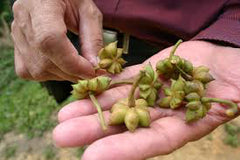
Spice Profile: Star Anise, Illicium Verum
Star Anise is pronounced as star \ˈa-nəs\ , scientific name Illicium Verum. Anise is often mispronounced. Hear the correct pronunciation.
Also Known As
Star Anise is also known as star anise seeds, star aniseed, Chinese star anise, anise stars, Chinese anise, Indian anise, chakra phool, and takkola.
What is Star Anise?

Star Anise is a spice that is widely used in cooking and home remedies. It is the dried, star-shaped fruit of a small oriental tree. It’s rust-colored, has tough skin, and can measure to over 1” long. Each star has between five and ten pointed sections, with an average of eight sections/points, and each section has a seed pod.
What Does Star Anise Taste Like?
Star Anise tastes and smells like licorice, sweet and bitter. It’s less intense than black jelly beans or licorice liquor, but it can still be overpowering in large amounts.
Are Star Anise and Anise Different?
Star Anise is often confused with Anise, thought are entirely different.
While they have a similar flavor, they come from different plants. Star Anise comes from an evergreen tree and Anise comes from an Anise plant in the parsley family.
Star Anise is more pungent and stronger in flavor than Anise. Both Star Anise and Anise contain an essential oil called anethole, which accounts for their similarities in flavor. Anethole is also found in licorice and fennel seed.
Some say that because Star Anise is less expensive to produce but provides comparable flavor, it may gradually replace Anise in many culinary uses.
Are Star Anise and Japanese Star Anise Different?
Star Anise or Chinese Star Anise is used in cuisine and medicines, while Japanese Star Anise is poisonous and must not be consumed.
How Can I Use Star Anise?
Culinary Uses and Star Anise Recipes
Enhance the flavor of meat and seafood, including duck, pork, veal, fish, poultry, shrimp, and braised beef.Infuse into soups, stocks, marinades, sauces and rices to add a warm, spicy undertone.
- Star Anise Sauce Recipe
- Chinese Style Beef in a Star Anise and Soy Marinade Recipe
- Easy Vietnamese Pho
Liven up your dessert. Add it to ginger cookies, baked apples, breads, pastries, pudding, strudels, or other types of desserts. Ground Star Anise also protects baked goods from spoiling due to bacteria or fungi.
Spice up a fruit compote or jam. Or season poached figs, pears and plums, or tropical fruits.
- Dried Apricot Chutney with Star Anise Recipe
- Cranberry Sauce with Zinfandel, Star Anise, and Black Pepper Recipe
- Make Chinese Five Spice Powder and use it in meat marinades or dry rubs to provide unexpected and warming flavors. Star Anise is a featured ingredient, alongside cloves, fennel seeds, Chinese cinnamon (cassia) and Sichuan pepper.
- Make Chinese Tea Marbled Eggs, a decorative hors d’oeuvre or snack.
Prepare in Indian cuisine or make Garam Masala. Star Anise in Hindi is Chakriphool or Chakra Phool.
Make Vietnamese Pho, a noodle soup.
Make a refreshing Traditional Thai Iced Tea With Star Anise.
Try it in an alcoholic beverage. It’s used to make anisette (an anise-flavored liqueur favored in Mediterranean countries), Pastis (an anise-flavored aperitif from France), and Galliano (a sweet herbal liqueur).
Household Uses
- Use in craft projects or potpourri for its beautiful shape.
- Chew it after a meal to sweeten your breath
- Use Star Anise oil in soap, toothpaste, mouthwash, skin creams, tobacco and perfume.
Preparation methods
- Star Anise is available in whole stars, pieces, and ground form. It’s usually used in small amounts because the spice is powerful.
- The whole stars can be added directly to the cooking pot and are often removed from sauces, soups and stews before the dish is served.
- Pieces are referred to as segments, points and sections.
- Ground Star Anise is fully incorporated in the dish.
- Store Star Anise in an airtight container and it will it keep for over a year. Discard it when the flavor and aroma fade.
Where Can I Buy Star Anise?
Star Anise is available at specialty spice stores in whole form, broken pieces, or ground into a powder. If you want to buy it online, try Penzey’s.
Health Benefits of Star Anise
Fights Influenza: Star Anise is a major source of the chemical compound shikimic acid, which has anti-viral effect, can help the body’s immune system fight off many strains of the flu, and is used in the pharmaceutical synthesis of anti-influenza drugs, like oseltamivir phosphate. Shikimic acid is found in the seeds of Star Anise. In fact, about 90% of Star Anise is purchased by the pharmaceutical industry to make anti-influenza drugs.
Relieves Cough and Sore Throat: Star Anise contains the organic compound anethole, which is antibacterial, antifungal, and can act as an expectorant. Star Anise is often used to relieve bronchial cough, asthma, dry cough and sore throat symptoms either through the ingestion of Star Anise tea or breathing steam from boiling Star Anise. Star Anise is also a common flavoring for cough mixtures and pastilles.
Aids Digestion: Star Anise can improve digestion and promote appetite, while reduce bloating, cramps, gas, indigestion and constipation.
Reduces Muscle and Joint Pain: Star Anise oil is used in very small doses to relieve muscle pains and provide relief from rheumatism and lower back pain.
Targets Free Radicals and Environmental Toxins: Star Anise is rich in antioxidants and Vitamin A and C, which help fight against free radicals and environmental toxins that are responsible for the aging process, diabetes, heart disease, and the beginnings of cancer. You can’t really avoid free radicals, which are byproducts of your body’s metabolic processes, but you can neutralize them by eating a diet rich in antioxidants. Statistical studies have shown that populations of Southeast Asia who consume Star Anise along with Turmeric and Coriander have a much lower rate of gastric, intestinal and lung cancer.
Other Traditional Chinese Medicine: In traditional Chinese medicine, Star Anise is also used to promote the health of female reproductive organs, to increase breast-milk secretion in lactating mothers, to alleviate premenstrual syndrome, promote a good sleep, and increase libido.
Substitutes for Star Anise
Suitable substitutes for 1 Star Anise include:
- ½ teaspoon ground Star Anise
- ½ teaspoon crushed Anise Seed in equal amounts plus a pinch of Allspice
- ½ teaspoon Chinese Five Spice Powder
- ¼ to ½ teaspoon Anise Extract
- ¾ teaspoon Fennel Seed
What is the History of Star Anise?
Star Anise is thought to be native to southern China and northeast Vietnam and it is difficult to determine if it is wild or naturalized. Star Anise been cultivated since about 2,000 BC and its culinary use dates back to the 17th century.
Today, Star Anise is mainly cultivated in China, Laos, Vietnam, Korea, Japan, Taiwan, Hainan and the Philippines.
How to Grow and Plant Star Anise
Star Anise is the fruit of a small to medium evergreen tree of the magnolia family. The tree grows up to 26 feet tall and the trunk can grow to 25 cm in diameter, with white bark. The Star Anise tree leaves are glossy and lanceolate and the flowers are yellow-green, or sometimes flushed pink to red.. Star Anise trees can bear fruit for up to 100 years.
The Star Anise fruits are picked before they ripen, when the essential oil is high in the star-shaped shell, and sun-dried until it become greyish-brown in color. Star Anise plants give off a strong and pleasant aroma, which makes it appealing to grow.
Star Anise plants are propagated from cuttings or seed which nestle inside the points of the star-shaped fruit. To plant Star Anise, sow the seeds in the spring under cover and grow indoors until at least the following year. Then, transplant the Star Anise plant outside in the most sheltered spot you can find, as it cannot take temperatures lower than about 23 degrees Fahrenheit.
If your climate gets too cold for the Star Anise plant to be outside in the winter, try growing it in a container and moving it inside when the weather outside is too cold. The Star Anise plant will grow to be a small tree, but many trees grow happily in containers.
Star Anise in Other Languages
- Hindi: chakriphool or chakra phool
- Thai: chan tanat paetklip
- Chinese: ba chio, ba(ht) g(h)ok, bart gok, pa-chiao, pak kok, peh kah
- Indonesian: bunga lawang
- Spanish: anis estrllado, badian
- French: anis de la Chine, anise étoilé, badiane
- German: Sternanis
- Italian: anice stellato
Sources
- http://www.food.com/about/star-anise-345
- World Spice at Home By Amanda Bevill and Julie Kramis Hearne
- Herbs and Spices by Jill Norman
- The Drunken Botanist by Amy Stewart
























